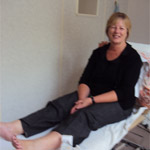Why it’s important to not overlook your balance
Here’s an understatement if ever there was one: having good balance is very important. And for more reasons than one.
Just thinking about it. Your balance is tested through every step of life you take (quite literally). It’s put to the test daily when you walk, when you go from a standing position to a seated one and vice versa.
Osteopath Denise Callaghan says: “And, as we age, bones tend to shrink in size and density and our muscles can lose flexibility, endurance, and strength. This is known as sarcopenia. And it’s all of these factors that can affect our coordination, stability and perhaps most importantly, our balance.”
The facts
According to the National Institute of Ageing (NIA), more than one in four people age 65 and over will experience a fall each year.
Along with reflexes, foot problems and some medications, the Institute also puts these falls down to problems with balance.
But it’s not just the NIA who is raising awareness about the importance of maintaining your balance. A 2021 journal published in The Cureus Journal of Medical Science saw researchers conclude: “Balance in older people deserves special attention because of its importance in functional mobility and safety. With the increase in the aging population and increased life expectancy, maintaining functional status is becoming very important. Balance discrepancy is one of the major risk factors for falls among older adults. A high correlation was found between balance deficit and fall incidence.”
While a second study found muscle weakness is associated with: “An increased risk of falls, hip fractures, and adverse physiological changes such as osteoporosis.”
How to improve your balance
But while there’s nothing we can do about the process of ageing, there are factors we can do to better your balance and work against the natural changes:
- Stay physically active
“Along with helping your balance, this can aid your overall health and keep your wellness on track too,” Denise says.
When we speak of saying active, this doesn’t have to involve completing a marathon, training to become a body builder or taking part in netball matches. It just means you need to spend more time moving and less time sitting.
“Keeping active by climbing stairs or going for a brisk walk each day helps keep your joints, ligaments and tendons flexible,” Denise adds. “It also can help slow bone loss.”
- Strength train
We know that ageing is associated with progressive decline in overall muscle strength. Which, as we’ve seen, can lead to an increased risk of falls. “However, one way to combat this is to practise resistance training,” Denise says.
Resistance training or strength training is the art of using weights – be it free weights or bodyweight exercises – to better your overall strength. According to researchers who looked into whether strength can help improve balance, they came to the conclusion: “Improvement in lower limb strength may lead to balance enhancement in neurologically intact older persons.”
Exercises such as the below can help better your balance:
- A one-legged stand – start by holding yourself on the back of a chair and lift one foot in the air. Hold this pose for 10 seconds and repeat 10 times. Overtime you should be able to complete this exercise without holding onto anything.
- Squats – this compound exercise can be completed with just your bodyweight or with a barbell if you’ve been practising this for some time. Start by standing with your feet slightly wider than your hips with your toes pointed forward. Bend your knees and bring your bottom to the ground as if you are about to sit down. Before you do, stand back up. Repeat 10 times.
- Leg extension – you can practice this move by sitting on a chair and raising one of your legs until it is straight and then placing it back on the floor. You will be able to add weights to this movement if you head to a gym. It will train your quadriceps and your upper legs.
- Practise yoga
Yoga brings with its many benefits. One of which is better balance. As found in a piece of research published in the International Journal of Yoga, there is: “Substantial evidence that postural control in healthy young adults can be improved through practicing hatha yoga”.
While a second journal found yoga-based exercise can improve balance and mobility in people aged 60 and over.
Some yoga moves such as the mountain pose, the balance table pose or the side plank pose can test your balance. “Try taking a yoga class or head over to YouTube to find a flow you can follow,” Denise says.
If you are struggling with any other mechanical issues, be it stress, lower back pain, food issues or stress, drop Denise an email or give her a ring to see if she can help you relieve these symptoms.





















